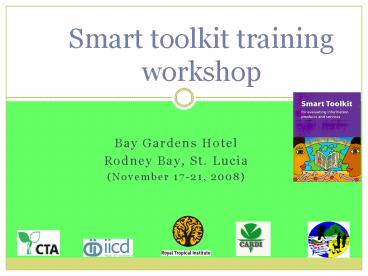Smart toolkit training workshop PowerPoint PPT Presentation
1 / 30
Title: Smart toolkit training workshop
1
Smart toolkit training workshop
Bay Gardens Hotel Rodney Bay, St.
Lucia (November 17-21, 2008)
2
Video for development
3
- Why video?
4
Video for development
- Video is an excellent medium for disseminating
information and many organizations have made it a
central part of their communication strategy. - The widespread use of video is due not only to
its ability to reach a large audience (in
particular by television broadcasting) and its
distinct impact (we remember what we see and hear
better than words alone) - Its large-scale use is undoubtedly due to the
fact that production has become technically and
financially more accessible. - The recent developments in Internet broadcasting,
such as YouTube and BlipTV, are also evidence of
a trend towards mass public broadcasting
previously restricted. - See also http//video.cta.int/
5
Potential use of video in development
Source http//talksharelearn.wordpress.com/2008/0
9/30/writeshop-on-video-for-development/
6
What is Participatory Video
7
The best way is to watch PV in action!
- http//www.insightshare.org/video_insightintro_07.
html
8
What is PV (adapted)
- Participatory Video (PV) is a set of techniques
to involve a group / community / organisation /
multi-stakeholder platform in shaping and
creating their own film. - This process can be very empowering, enabling a
group / community / organisation /
multi-stakeholder platform - To take action to solve their own problems and
also - to communicate their needs and ideas to
decision-makers and/or other stakeholders .
9
Benefits of PV
- PV can become a powerful means of documenting
local people's experiences, needs and hopes from
their own perspectives. - It initiates a process of analysis and change
that celebrates local knowledge and practice,
whilst stimulating creativity both within and
beyond the community. - When done well, PV presents the "inside view" in
a lively way that is accessible to people at all
levels.
10
Benefits of PV
11
Benefits of PV
- All community members have equal access to the
process. All voices are expressed and heard. - The video medium is transportable, easily
replicated and easily shared it thus has a wide
"spread effect". - PV gives a voice and a face to those who are
normally not heard or seen, even in participatory
programmes that focus on identifying local
innovations and enhancing endogenous development
12
How does PV work?
13
How does PV work? (adapted)
- Quick learning through the use of games and
exercises. - Facilitators guide the process, using e.g. PLA
methodologies and tools. - Short videos and messages are directed and filmed
by the participants. - Footage is shown to the wider community /
stakeholder group at daily screenings. - A dynamic process of participant-led learning,
sharing and exchange is set in motion.
14
Potential use of PV
15
Potential use of PV
- PV is a tool with great potential to stimulate
(local) innovation processes. - PV can stimulate organisational learning
- PV can stimulate dialogue and social learning
within and between stakeholder groups. - PV can be used for monitoring and evaluation,
e.g. in combination with the Most Significant
Change (MSC) Technique.
16
Potential use of PV
- Horizontal communication (e.g. with other
community groups) and vertical communication
(e.g. with policy makers). Feedback loops! - Promoting awareness, fund raising etc.
17
More info on PV
18
More information about PV
- http//insightshare.org
- http//insightshare.org/PV_nutshell.html
- http//www.insightshare.org/video_insightintro_07.
html - http//www.insightshare.org/pdfs/PLA20PV20ARTICL
E2007.pdf
19
Video making tips
20
Production phases
- Pre-production
- Production
- Post-production
21
Pre-production phase - preparations
- Concept development, idea of story
- Plan movie
- What? Why? Where? How? Who? When? in bigger
productions - E.g. for short interviews what do you want to
show, what questions to ask - Develop a storyboard what shots do you need?
- For web short movies, up to 3 minutes
22
Pre-production phase - preparations
- Types of Shots
- Close-ups (powerful) most used for web-viewing
- Medium shots
- Wide shots (lots of information) not useful for
web-viewing - Cut-away shots a shot of something other than
the current action (filling)
23
Type of shots - examples
- Close-up Medium shot
- Most used for web viewing (powerful)
- Wide shot Cut away shots
- Not useful for web viewing (lots of
information) a shot of something other than the
current - action (filling)
24
Production phase actual shooting
- Tips for filming
- Avoid camera movement (use tri-pod where
possible) - Avoid panning (moving with a moving object)
- Avoid zooming (Better to move in than zoom)
- 180 degree rule
- Avoid backlight
- Shoot 10 15 seconds per shot to allow for
editing - Let the tape run 20 seconds at the beginning of
the tape and a bit at the end as well (with video
camera)
25
Production Phase actual shooting
- Sound
- make sure surrounding sounds are kept to a
minimum, the camera will pick up all surrounding
sounds - Clean time code (video camera only)
- Unique 8-digit numerical sequence
hoursminutessecondsframes - Keep a clean timecode!!!
26
Post-production Phase
- Compiling and finishing movie
- Editing
- Windows Movie Maker
- Sound
- Titles
- Voices
- Exporting for release on web (blip.tv)
27
Practice make your own video
28
Exercise learn to shoot and edit a film
- Shoot a few minutes film
- Try out editing (with help of facilitators)
29
Exercise for the group work on methodologies
story board film
- Decide on a topic keep it simple! E.g. food at
the hotel, the workshop etc. - Make a story board to describe the story you
want to tell in a 3-minute film - Shoot the film
- Edit the film
30
Shooting and editing
- Have fun!

